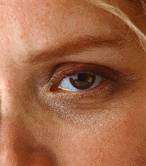Retina's thickness may be tied to severity of MS, study suggests

(HealthDay)—Using a high-tech imaging process to measure the thickness of the eye's retina may one day predict the progression of multiple sclerosis, a new study suggests.
The finding might lead to better ways to judge the effectiveness of treatments because different parts of the retina seem to indicate different aspects of the disease and the toll it takes on different parts of the brain, the researchers said.
The report was published online Oct. 1 in the Archives of Neurology.
Multiple sclerosis is thought to be an autoimmune disease that attacks the central nervous system, which consists of the brain, the spinal cord and optic nerves. Symptoms range from mild effects, such as numbness in the limbs, to severe, such as paralysis or blindness.
"In treating multiple sclerosis we have been tremendously successful in reducing the number of attacks," said Dr. Ari Green, assistant clinical director of the Multiple Sclerosis Center at the University of California, San Francisco, and author of an accompanying editorial in the journal.
That's the inflammatory part of the disease, Green explained. "We are very successful at treating inflammation in multiple sclerosis. We are less successful in being able to treat or reverse disability," he said.
Methods that help speed up the testing of therapies are needed if progress in treating the disability caused by MS is going to happen, Green said.
And because the retina is part of the central nervous system, it's like a window to the brain and can provide a lot of information about different areas of the brain, he explained.
"If we can figure out how to properly use this imaging [called optical coherence tomography]—perhaps with other tests—for predicting disability in multiple sclerosis, we could accelerate therapies that could make a difference in patients' lives," Green said.
The retina is the light-sensitive layer of tissue at the back of the inner eye. It switches images to electric signals and sends them through the optic nerve to the brain.
For the new study, the researchers looked at the retinas of 84 patients with multiple sclerosis and compared them with 24 healthy people.
"The inner and outer retinal layer thickness, measured by optical coherence tomography, may reflect global and potentially distinct central nervous system processes in multiple sclerosis," said lead researcher Dr. Shiv Saidha, a neurologist at Johns Hopkins University.
These findings may not be associated with the condition of the eye, but rather with changes in the brain itself, he said.
"If confirmed, the implications of our study findings are that OCT [optical coherence tomography]—a relatively inexpensive, non-invasive, well-tolerated, reproducible and easily repeatable investigation—may be a complementary technique to MRI [magnetic resonance imaging], providing useful information regarding the global aspects of the multiple sclerosis disease process," Saidha said.
The imaging technique may help researchers evaluate the effectiveness of new treatments because their impact might be reflected in changes in the retina, Saidha added.
Green said the technique might also have similar potential for other brain diseases such as Parkinson's and Alzheimer's disease.
"Everything we have tried to prevent neurodegeneration so far has failed," Green said. "We don't have any treatments in that area that are of proven benefit the way we do in heart disease and cancer. So it's a huge unmet need to treat neurodegenerative disease."
More information: To learn more about multiple sclerosis, visit the National Multiple Sclerosis Society.
Copyright © 2012 HealthDay. All rights reserved.














